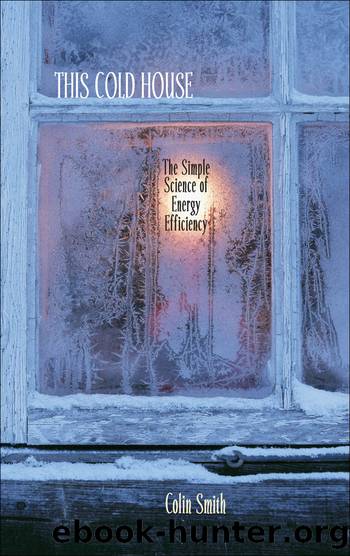This Cold House by Colin Smith

Author:Colin Smith
Language: eng
Format: epub
Publisher: Johns Hopkins University Press
Published: 2007-09-15T00:00:00+00:00
Gas Fires
As long ago as 1626, French explorers found Native Americans igniting a mysterious gas around Lake Erie, the first known American use of natural gas. Its first commercial use was in 1816, when the streets of Baltimore were lit by gas manufactured from coal. Indeed, throughout the nineteenth century, gas was used almost exclusively as a source of light rather than heat.
The yellow flame used for lighting was, as discussed in Chapter 4, due to incomplete combustion arising from inadequate oxygen supply. The flameâs source of oxygen is the surrounding air, which is swept into it and rises with it by convection. But not nearly enough air can be supplied in this way for complete combustion, which requires an optimum mixture of about one part gas to three parts air.
It wasnât until nearly seventy years after those natural gas streetlights that the German Robert Bunsen perfected his burner design that made gas heating a viable commercial proposition. His simple but brilliant idea was to mix the gas with air before it reached the flame, which produced the almost colorless flame with the blue cone characteristic of all gas burners. The temperature just above this cone can reach 2700°F, plenty hot enough for cooking and heating!
The design of burners for gas fires is still based on Bunsenâs original ideas. Gas is introduced through a jet, and air is supplied through a throat-like opening within the pipe leading to the jets. This opening must be kept clear at all times to ensure that sufficient air can enter it. Control is automatic, for when the gas supply is turned up the gas rushes more quickly to the burner, drawing more air into itself, rather like the flood waters of a stream dragging parts of the bank with it. The whole thing is carefully engineered to ensure that all the gaps and jets are the right size, and there are often a number of small jets arranged to fit the shape of the appliance.
An early problem with gas fires and stoves was the arrangements for ignition. Long tapers or special gas lighters were needed to avoid burning the user. Later these were abandoned in favor of pilot lights, permanently burning small flames from which the main burners could be ignited when the gas was switched on. This, however, wastes gas, and nowadays press-button spark ignition is used: one small step for the environment.
The best-performing gas fires in terms of cost and energy efficiency are the enclosed direct-vent design, as shown in figure 5.6, where 100% of the combustion air is drawn from outside the house and 100% of the exhaust air is expelled to outside the house.
Download
This site does not store any files on its server. We only index and link to content provided by other sites. Please contact the content providers to delete copyright contents if any and email us, we'll remove relevant links or contents immediately.
Harry Potter and the Goblet Of Fire by J.K. Rowling(3045)
Unfinished: A Memoir by Priyanka Chopra Jonas(2916)
Never by Ken Follett(2880)
The Man Who Died Twice by Richard Osman(2298)
Machine Learning at Scale with H2O by Gregory Keys | David Whiting(2290)
Fairy Tale by Stephen King(2069)
Will by Will Smith(2041)
Rationality by Steven Pinker(1765)
The Storyteller by Dave Grohl(1660)
The Dawn of Everything: A New History of Humanity by David Graeber & David Wengrow(1570)
The Dark Hours by Michael Connelly(1569)
The Stranger in the Lifeboat by Mitch Albom(1532)
Cloud Cuckoo Land by Anthony Doerr(1434)
The Becoming by Nora Roberts(1330)
Friends, Lovers, and the Big Terrible Thing by Matthew Perry(1327)
New Morning Mercies: A Daily Gospel Devotional by Paul David Tripp(1323)
Einstein: His Life and Universe by Walter Isaacson(1315)
Crying in H Mart by Michelle Zauner(1315)
A Short History of War by Jeremy Black(1300)
